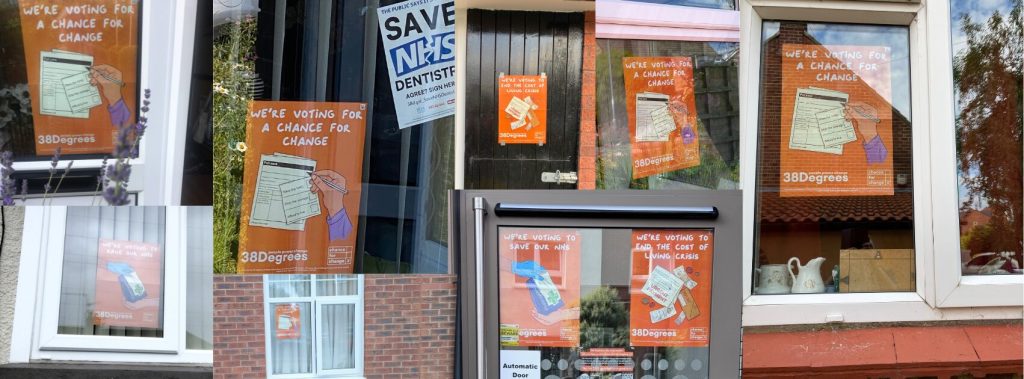
Jun 27th, 2014
Recall Draft Bill
By becky
To read the Bill in full click here: https://secure.38degrees.org.uk/recall-draft-law
Glossary of terms used:
What is a returning officer?
A returning officer is an employee of the Council with the responsibility of overseeing elections in their area.
What is a notice of intent?
That’s the name the lawyer has given to the first stage of the recall process which requires 5% of the constituency to sign their names in favour of a recall petition. This is basically a petition – but it has a different name so it isn’t confused with the recall petition notice which is the next stage of the process.
What is a recall petition notice?
If the notice of intent is successful, the returning officer will then publish a recall petition notice – which is basically the same as the first stage of the process, but more constituents need to sign up!
What is the process?
The 38 Degrees draft law says that an MP can have a recall petition started against them if:
A successful notice of intent to recall an MP has been submitted to a returning officer.
A notice of intent is successful if it has been signed by 5% of voters in the constituency within the previous 28 days. Signatures can be gathered electronically or in person.
If the notice of intent has signatures from 5% of voters in the constituency, the returning officer will issue a recall petition.
There will be four places in the constituency where voters can sign the petition. Within two weeks, the petition will be published for voters to sign. They’ll then have 8 weeks to sign the petition.
A successful recall petition needs to receive signatures from 20% of voters in the constituency.
If the recall petition is successful, there will be a recall referendum in the constituency.
The referendum has to happen no less than 21 days, and no more than 27 days, after the issue of notice has been given. A referendum cannot happen within 6 months of a general election.
If the majority of voters in the constituency vote for their MP to be recalled at the referendum, a by-election will be called.
Where people will be able to vote for who they want has their MP.
More information on the draft law as it stands
How is the notice of intent different to the recall petition?
They’re both basically petitions, but the notice of intent only needs to be signed by 5% of voters in the constituency while the recall petition needs to be signed by 20%.
Why are there 5% and 20% thresholds?
The thresholds have to be low enough to make sure that recall can happen, but high enough to ensure that they cannot be abused. The thresholds are similar to those in recall legislation around the world.
What happens if an MP is subject is charged with breaking the law?
When an MP has been charged with an offence that means they have to go to court, the recall process is paused. Once a ruling has been made it can start again. This is to ensure that the MP gets a fair trial.
Why is there not a ‘trigger’ (or qualifying criteria) for the recall process?
It is impossible to define ‘serious wrong doing’. It has been tried, but there has never been a consensus on what constitutes serious wrongdoing. Some people, including the government, think that there should be triggers which initiate recall – for example, if an MP goes to prison. But there are examples of MPs going to prison for taking a stand that has been welcomed by constituents (eg Terry Fields MP was jailed in 1991 for refusing to pay the Poll Tax). The process puts in enough checks and balances to ensure that recall can only be initiated where demand is very high.
Why are there timeframes involved?
The timeframes have been designed to make sure the recall process moves forward at a reasonable pace, while also allowing enough time for the returning officer to organise the logistics. Where possible this draft law has aligned the timeframes with existing laws e.g. with the law for by-elections.
Why are there so many steps?
Because there aren’t any particular circumstances set out for what starts the recall process in the 38 Degrees draft law. This is to that voters can decide – but is also means that recalling an MP won’t be easy – which will give them job security and make them more likely to pass it.
How do we ensure that the law isn’t abused by political opponents of an MP or time wasters?
This process aims to put in sufficient checks and balances to prevent the tool being used by individual time wasters. That is why at every stage there are time limits and thresholds to demonstrate a genuine demand for the process.
Who can sign the notice of intent and recall petition?
Anyone who is registered to vote!
How does the returning officer ensure that the the recall petition is valid?
There’s a lot of detail on this in the draft law. The returning officer will be able to see whether all of the signatures on the petition are voters registered in the constituency.
Why can’t the recall process take place 6 months before a general election?
It doesn’t make sense to initiate recall 6 months before an election because if a recall referendum is successful, the subsequent by-election would take place very close to the General Election.
Can a recalled MP fight the seat in the following by-election?
Yes
Who will be liable for the costs associated with the recall process?
This will be paid for by central government.
To read the Bill in full click here: https://secure.38degrees.org.uk/recall-draft-law
To fill in the survey with your thoughts about the draft bill click here: https://secure.38degrees.org.uk/recall-poll
















